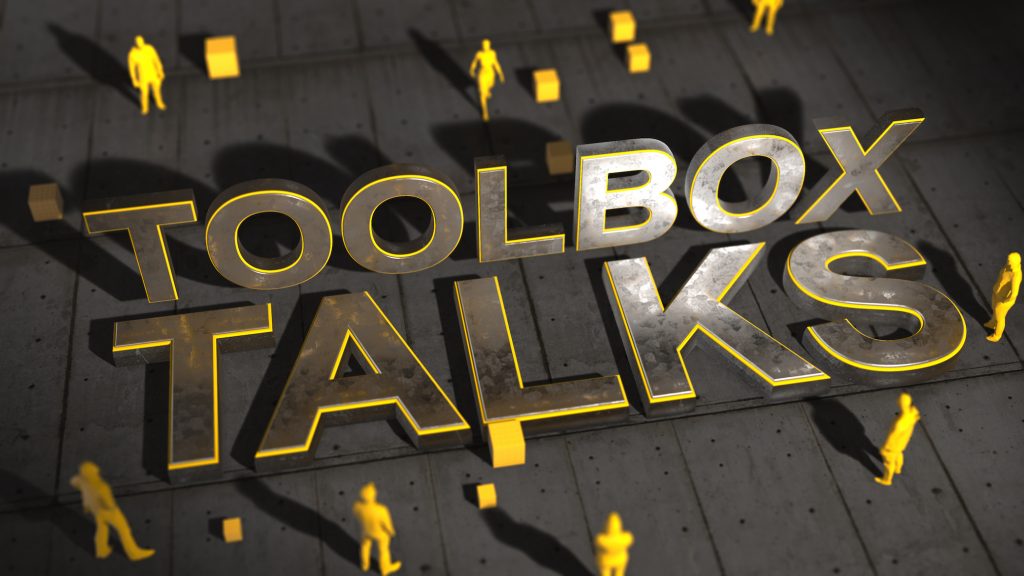The Bureau of Labor Statistics reported 2.8 million non-fatal workplace injuries in 2019. Unfortunately, up to 5,333 U.S. workers die on the job due to fatal injuries, including forklift-related hazards, loading docks and conveyors, and handling hazardous materials. Thus, workplace safety should be one the top of every employer’s list. In this blog post, we’ll discuss how daily toolbox talks can help create a health and safety culture by forming a robust health and safety management system:
Understanding Toolbox Talks
“Toolbox Talks” are safety meetings that last five to fifteen minutes to refresh workers’ knowledge. Holding toolbox talks at the start of the workday ensures safety is a priority for everyone.
Research by the Associated Builders and Contractors reveals that regular safety toolbox talks can decrease workplace incidents by a whopping 82%.
Who Needs to Use Toolbox Talks?
They entail short discussions between coworkers to ensure workers are up-to-date with health and safety standards. With these meetings, your team can avoid accidents. Any industry or company can utilize toolbox talks. If you value safety at your workplace, then toolbox talks are for you.
Here are several examples of topics:
- Construction, manufacturing, or masonry crew discussing working in severe weather, slips and falls, constructing in confined spaces, trenching hazards, etc.
- Office workers may hold a toolbox talk on the appropriate use of fire extinguishers, accident reporting, ergonomics, work time management skills, and more
- Warehouse distribution center managers may discuss the best safety practices of powered lifts, conveyors, forklifts, etc.
Top 5 Reasons to Start Using Toolbox Talks Today
Although there are no legal requirements to conduct these talks, holding them can highlight safety topics and ensure it’s at the front of everyone’s mind.
Here are five reasons why having regular toolbox talks is critical to keeping you and your team healthy, safe, and injury-free throughout the year:
Get Workers Up-to-Date Quickly and Efficiently
Regardless of your industry, some of your safety practices have likely altered. In some cases, it might be a worksite change; other times, it might be a change in official regulation.
Having a meeting is an excellent way of reinforcing changes to policies and rules. Coworkers might discuss new procedures the industry will implement and how the alterations will affect them. Employees will recall changes better if they are highlighted repeatedly, thus keeping workers safe and protected.
Raise Awareness on “Low Priority” Topics
Raising awareness refers to knowledge or perception of a situation. While all safety topics are technically necessary, some high-risk issues require in-depth coverage, whereas others need to be brought to attention.
Toolbox talks are the perfect opportunity to raise awareness of lower-risk healthy subjects that don’t warrant hour-long training courses. For instance, you don’t need to hire a third-party safety training expert or conduct an entire training course on how horseplay can cause severe workplace incidents. However, you can hold a five to ten minutes toolbox talk discussing this issue.
To Ensure Everyone Remembers Health and Safety Rules
Did you know that the OSHA labor act requires employers to provide employees with information, instruction, and training?
While toolbox talks are not an alternative to health and safety training courses, they’re an excellent way of keeping health and safety standards fresh in everyone’s mind.
To Stay Alert during Work
Picture this: your employee overslept or is not really a morning person. Safety or being 100% alert right when they get to work might not be the case.
Regular toolbox talks will refresh health and safety rules and raise awareness before work (we will talk about what “regular” means later in this post).
Cultivate a Culture of Safety & Save Money
Slips, fall, and trips are among the top unintentional injury-related deaths. Companies can keep workers safe and save money simply by cultivating a positive health and safety environment. Fewer accidents mean less money paid in workers compensation insurance premiums.
However, fostering a healthy, safe, and happy culture takes time and effort. So, be ready to invest time in regular toolbox talks and energy in emphasizing proper safety procedures.
Additional Toolbox Talk Notes:
- When toolbox talks are conducted, have a sign-in sheet with everyone’s name, the date, topic, and location.
- How often should you hold toolbox talks? This depends on your industry and company. Let’s say you are a construction company, the risks in day-to-day activities are pretty high. Starting every day with a toolbox talk can help keep safety top of mind. This also goes for companies that may be struggling with the number of on-the-job injuries. Let’s say your company has less risk and limited injuries, having a toolbox talk once a month would suffice. A happy medium would be once a week.
- Who should be leading toolbox talks? Have a supervisor or head of HR lead these talks.
- Changing the name to “safety minute” or “weekly safety meeting” might be beneficial depending on the tone you want to set.
The Bottom Line
Luckily, incorporating toolbox talks into the workday schedule is pretty straightforward. If you’re wanting to incorporate toolbox talks, consider connecting with a third-party platform. At Mod Advisor, you can have access to valuable, insightful toolbox talks for construction, manufacturing, trucking, and general office. Talk to your insurance agent about using Mod Advisor, and reach out to us at [email protected].

